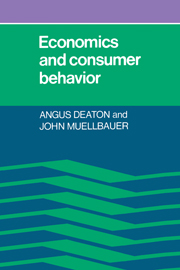Book contents
- Frontmatter
- Contents
- List of tables and figures
- Preface
- PART ONE CONSUMER DEMAND ANALYSIS
- PART TWO SEPARABILITY AND AGGREGATION
- PART THREE WELFARE AND CONSUMER BEHAVIOR
- 7 Consumer index numbers
- 8 Household characteristics, demand, and household welfare comparisons
- 9 Social welfare and inequality
- PART FOUR EXTENSIONS AND APPLICATIONS
- References
- List of notation
- Name index
- Subject index
7 - Consumer index numbers
Published online by Cambridge University Press: 05 June 2012
- Frontmatter
- Contents
- List of tables and figures
- Preface
- PART ONE CONSUMER DEMAND ANALYSIS
- PART TWO SEPARABILITY AND AGGREGATION
- PART THREE WELFARE AND CONSUMER BEHAVIOR
- 7 Consumer index numbers
- 8 Household characteristics, demand, and household welfare comparisons
- 9 Social welfare and inequality
- PART FOUR EXTENSIONS AND APPLICATIONS
- References
- List of notation
- Name index
- Subject index
Summary
Index numbers of prices, output, and welfare are part of the common parlance of economic debate. Yet the theory of economic index numbers, which has attracted some of the best minds in economics over the years, had until very recently been rather unfashionable. Few modern texts include more than passing references to index number theory, and the topic seems to be regarded as a rather unimportant backwater. However, the increase in rates of inflation in recent years has brought renewed interest in the measurement of price indices, while the realization that inflation affects different groups differently had rendered the quantification of these differentials an important element in assessing inequality between households or individuals.
In the context of consumers, economic index numbers attempt to construct a single ratio that measures one of two things. The first, the cost-of-living index, measures the relative costs of reaching a given standard of living under two different situations, while the second, the real consumption index, compares two different standards of living in some appropriate units. As we shall see, the most convenient scale with which to measure welfare is the expenditure necessary, at constant prices, to maintain the various welfare levels being considered. These concepts, which use money to measure changes in welfare, can only be applied to situations where money and welfare are uniquely linked. This will not be the case where goods that are important for consumers' well-being are not purchased through the market; examples are health care, public parks, clean air, a noise-free environment, or some kinds of education.
- Type
- Chapter
- Information
- Economics and Consumer Behavior , pp. 169 - 190Publisher: Cambridge University PressPrint publication year: 1980
- 3
- Cited by



